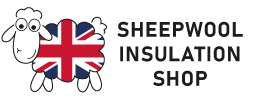Insulating a loft/roof space with Sheep wool Insulation is a highly effective way of reducing energy consumption in a building. This beautiful, natural product is extremely versatile and is more than suitable as an alternative to other forms of flexible insulation.
Cold roof / Loft Insulation
The easiest way to insulate a roof space is at ceiling level (loft floor). This installation method, allows a thick layer of insulation to be installed, offering high levels of energy efficiency. The recommended thickness of Sheep wool for loft Insulation is 240mm. Building regulations for new-build projects may require thicker insulation to achieve the required thermal values.
For lofts where no flooring is planned, a layer of wool insulation is placed between the joists, ensuring a tight fit to avoid air gaps. Subsequent layers are then run across the joists and butted together tightly to reduce the possibility of thermal bridging.
Where boards are being installed to create a floor, sheep wool insulation can be fitted tightly between the joists. Additional layers of insulation can be fitted between cross-laid joists using the same procedure.
Further considerations
Your loft should be in a good state of repair prior to installing insulation. Ensure there are no water leaks from the roof or from water tanks and pipes.
For properties with under-eve / soffit ventilation, insulation interrupters/rafter trays should be fitted to ensure the ventilation path remains open.
Check that ceilings are in a good visible state of repair and will not be affected by the additional weight of the insulation.
Insulation should not be installed under water tanks. Install additional insulation layers around the tank to meet up with the tank lagging.
As with other insulation products, ensure there are no visible defects in any electrical wiring present. It may be necessary to de-rate electrical cables that are buried in the insulation. Guidance should be sought from a qualified electrician.
Electric cables supplying storage heaters, immersion heaters, electric showers, electric cookers or solar PV shall not be covered by thermal insulation. Cables to these appliances should be lifted above the insulation.
Sheep wool Insulation should not be installed within 150mm of a working flue or Chimney.
Where appropriate, downlight covers should be used that meet part F and part B of the Building regulations.
